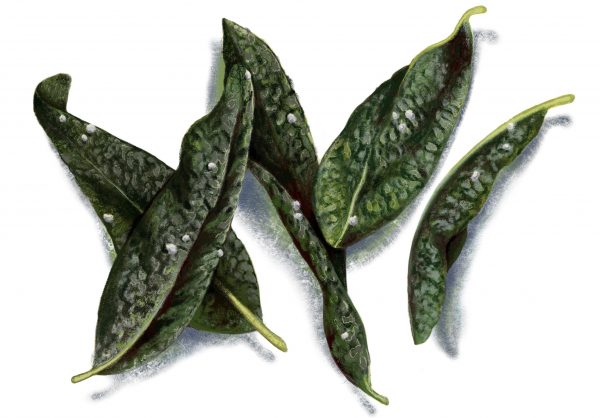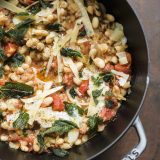
Fried fresh sage leaves—salvia fritta—are a simple, richly aromatic dish found across Italy, most often associated with Tuscany, Umbria and Marché. Basic versions call for briefly pan-frying whole leaves in olive oil until crisp, then sprinkling with salt. These often garnish pastas and risottos. Adding a batter—often little more than flour and sparkling water or beer—transforms them into a light starter. Either way, the result is deeply savory an pleasantly herbal.
Of the many bean dishes from Tuscany's mangiafagioli—bean eaters, a label they wear proudly—one classic particularly drew us in: fagioli all’uccelletto. The simple combination of white beans, sage and garlic exemplifies the clarity of flavor the region's cooks can pull from just a few ingredients.
Most impressively, we loved how their use one just one of those ingredients three ways transformed and elevated the dish. More on that in a moment.
The name means “beans in the style of little birds.” Which is to say, they are seasoned as one would cook pheasant or partridge. Historically, on Italian hunting estates, the monied classes would be served these fagioli as an accompaniment to what they bagged in the fields that day. For the masses, they might be served with sausages, but mostly would be a meal by themselves, a poor man’s protein stewed with tomatoes in a glazed terra-cotta pot.
Traditional recipes call for dried cannellinis, which requires soaking overnight. While we prefer cooking from dried beans, that isn't always practical. So we developed our recipe two ways—using dried and canned beans. The canned version gave us the speed we were after. And we were happy to find that canned white beans, particularly great northern and navy, held their shape and maintained the bite we wanted.
The dried bean version offered other benefits. In addition to an even more robust and satisfying texture, cooking the dried beans gave us an opportunity to add additional layers of flavor, namely in the form of a head of garlic and bay leaves in their cooking water.
But the key to this dish’s success was using sage three ways, which built complex flavor without a lengthy ingredient list. We started by sauteing fresh sage in a Dutch oven with fennel, garlic, onion and red pepper flakes.
The second dose of sage came as the beans cooked. We fried sage leaves in olive oil until crisp and deeply savory, then set them aside for use as a garnish. The oil left from frying them gave us the final hit of flavor—drizzled over the finished dish for a richly aromatic punch.
Related Recipes
March-April 2018

Sign up to receive texts
Successfully signed up to receive texts!
We'll only send our very best offers - Like a $15 store credit to start.
By entering your phone number and submitting this form, you consent to receive marketing text messages (such as promotion codes and cart reminders) from Christopher Kimball's Milk Street at the number provided, including messages sent by autodialer. Consent is not a condition of any purchase. Message and data rates may apply. Message frequency varies. You can unsubscribe at any time by replying STOP or clicking the unsubscribe link (where available) in one of our messages. View our Privacy Policy and Terms of Service.



